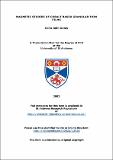Files in this item
Magnetic studies of cobalt based granular thin films
Item metadata
| dc.contributor.advisor | Riedi, P.C. | |
| dc.contributor.author | Oates, Colin John | |
| dc.coverage.spatial | 324 p. | en_US |
| dc.date.accessioned | 2018-03-13T11:12:15Z | |
| dc.date.available | 2018-03-13T11:12:15Z | |
| dc.date.issued | 2002 | |
| dc.identifier.uri | https://hdl.handle.net/10023/12928 | |
| dc.description.abstract | The magnetic recording media used for hard disks in laptops and PC's is constantly being improved, leading to rapid increases in data rate and storage density. However, by the year 2010, it is predicted that the superparamagnetic limit will be reached, which is potentially insufficient for data storage. At the beginning of this century, CoCr -based alloys are used in longitudinal media since cobalt has a high magnetocrystalline anisotropy. In this thesis, the static and dynamic properties of longitudinal recording thin films were investigated in order to explain and correlate their magnetic characteristics to their recording properties. The samples in question were test samples and some were in commercial use. Magnetic techniques such as high field ferromagnetic resonance and torque magnetometry were used to determine accurately the crystalline anisotropy field. High field ferromagnetic resonance is an ideal tool to determine the crystalline anisotropy, magnetisation, Lande g-factor and the gyromagnetic damping factor. In contrast to previous work, there are no FMR simulations and so all the relevant parameters were determined directly from measurement. Ideally, there should be no exchange interactions between the neighbouring cobalt grains; however, interactions between the grains within the CoCr-alloy recording layer exist. Previous work on the measurements of interactions in recording media involves measuring the sample's magnetisation. In this thesis, an alternative novel method involves torque magnetometry. Another technique that was used in this thesis is small angle neutron scattering, which aims to determine the size of the magnetic grains and compare that with the physical size determined from TEM, by Seagate. There is an extended section on CoxAg1-x granular thin films, which involves determining the sample's g-factor, effective anisotropy, grain size, exchange constant and comparing the FMR lineshapes at 9.5 and 92GHz. | en_US |
| dc.language.iso | en | en_US |
| dc.publisher | University of St Andrews | |
| dc.subject.lcc | QC176.84M2O7 | |
| dc.subject.lcsh | Thin films--Magnetic properties. | en |
| dc.title | Magnetic studies of cobalt based granular thin films | en_US |
| dc.type | Thesis | en_US |
| dc.type.qualificationlevel | Doctoral | en_US |
| dc.type.qualificationname | PhD Doctor of Philosophy | en_US |
| dc.publisher.institution | The University of St Andrews | en_US |
This item appears in the following Collection(s)
Items in the St Andrews Research Repository are protected by copyright, with all rights reserved, unless otherwise indicated.

